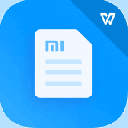


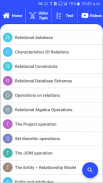

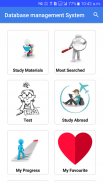
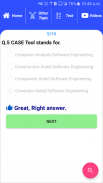

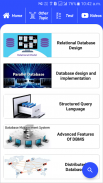
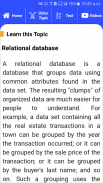
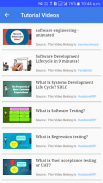
Advanced Database Management 1

Advanced Database Management 1의 설명
This unique free application is for all students of Advanced Database Management across the world. It covers 133 topics of Advanced Database Management in detail. These 133 topics are divided in 10 units.
Each topic is around 600 words and is complete with diagrams, equations and other forms of graphical representations along with simple text explaining the concept in detail.
The USP of this application is "ultra-portability". Students can access the content on-the-go from any where they like.
Basically, each topic is like a detailed flash card and will make the lives of students simpler and easier.
Some of topics Covered in this application are:
1. Parallel Database Architectures
2. Parallel Query Evaluation
3. Parallelizing Individual Operations
4. Parallel Query Optimization
5. Introduction To Distributed Databases
6. Distributed DBMS Architectures
7. Storing Data in Distributed DBMS
8. Distributed Catalog Management
9. Updating Distributed Data
10. Distributed Concurrency Control
11. Distributed Recovery
12. Two-Phase Commit Revisited
13. Three-Phase Commit
14. Introduction To Data Mining
15. Counting Co-Occurences
16. Iceberg Queries
17. Mining for rules
18. Tree structured rules
19. Clustering problem
20. Clustering Algorithm
21. Data Mining Tasks
22. Similarity Search Over Sequences
23. Object-oriented database systems
24. New Data Types
25. Abstract data type
26. Methods of an ADT
27. Structured data types
28. Manipulating Data of Structured Types
29. Objects and Refrence Types
30. Inheritance
31. Design for an ORDBMS
32. Challeges in Implementing an ORDBMS
33. OODBMS
34. Object Query Language
35. Compare RDBMS with ORDBMS
36. Transaction Processing Monitors
37. New Transaction Models
38. Integrated access to multiple data sources
39. Mobile Databases
40. Main memory databases
41. Multimedia Database
42. Geographic Information Systems
43. Temporal and sequence databases
44. Information Visualization
45. OODBMS; Advantages & Disadvantages
46. Data warehouse
47. Contrasting OLTP and Data Warehousing Environments
48. Data warehouses architectures
49. Logical versus physical design in data warehouses
50. Data warehouse Schema
51. Data warehousing objects
52. Logical and Physical Design of data warehouse
53. Introduction To Data Mining
54. Data Mining Uses
55. Data Mining Functions
56. Data Mining Technologies
57. Emerging Database Models
58. Multimedia Database
59. Temporal Databases
60. Designing Temporal Databases
61. Logical design of temporal databases
62. Conceptual design of temporal databases
63. Temporal databases implementation
64. Temporal DBMS implementation
65. Implementing Algebraic Operators Page
66. Database on the world wide web
67. Geographic Information Systems
68. Geographic information systems data operation
69. Example of a Geographic Information Systems-Arc-Info
70. Genome Data Management
71. Characteristics of biological data
72. Human Genome
73. Digital libraries
74. PostgreSQL
75. Functions of POSTGRESQL
76. Reliability on POSTGRESQL
77. open source software
78. Relational database
79. Characteristics Of Relations
80. Relational Constraints
81. Relational Database Schemas
82. Operations on relations
83. Relational Algebra Operations
84. The Project operation
85. Set theoritic operations
86. The JOIN operation
87. The Entity – Relationship Model
88. Entity and attributes
89. Pitfalls In Relational Database Design
90. Normalization
91. The Process of Normalization
92. First Normal Form (1NF)
93. Boyce.Codd Normal Form (BCNF)
94. Conceptual design
95. E-R Model Verification
96. logical design
97. Physical Design
98. Database Design Implementation
99. Testing and Evaluation
100. Security measures
101. Structured Query Language
102. SQL Statement
103. Creating and dropping tables in SQL
104. The SQL select statement
105. SQL select distinct statement
106. The AND & OR Operators
107. The ORDER BY Keyword
All topics not listed due to character limitations set by Play Store.이 독특한 무료 응용 프로그램은 전세계 고급 데이터베이스 관리의 모든 학생들을위한 것입니다. 그것은 세부 사항에있는 고급 데이터베이스 관리의 133 주제를 다룹니다. 이 133 항목을 10 개 단위로 나누어집니다.
각 주제는 약 600 단어이고 상세하게 개념을 설명하는 간단한 텍스트와 함께 다이어그램, 방정식과 그래픽 표현의 다른 형태의 완전하다.
이 응용 프로그램의 USP는 "매우 이식성"입니다. 학생들은 온 - 더 - 가서 그들이 좋아하는 곳에서 모든 콘텐츠에 액세스 할 수 있습니다.
기본적으로, 각 항목에 대한 자세한 플래시 카드처럼 학생들의 생활을 간단하고 쉽게 할 것이다.
이 응용 프로그램에서 다루는 내용의 일부는 다음과 같습니다 :
1. 병렬 데이터베이스 아키텍처
2. 병렬 쿼리의 평가
3. 개별 작업을 병렬
4. 병렬 쿼리 최적화
5. 분산 데이터베이스에 대한 소개
6. 분산 DBMS 아키텍처
7. 분산 DBMS에 데이터를 저장
8. 분산 카탈로그 관리
9. 분산 데이터 업데이트
10. 분산 동시성 제어
11. 분산 복구
12. 두 단계 재 방문을 커밋
13. 삼상 커밋
14. 데이터 마이닝 소개
15. 공동 발행 수를 계산
16. 빙산 쿼리
17. 규칙에 대한 마이닝
18. 트리 구조 규칙
19. 클러스터링 문제
20. 클러스터링 알고리즘
21. 데이터 마이닝 작업
22. 시퀀스 이상의 유사성 검색
23. 객체 지향 데이터베이스 시스템
24. 새로운 데이터 형식
25. 추상 데이터 유형
26. ADT의 방법
27. 구조화 된 데이터 유형
28. 구조화 된 유형의 데이터 조작
29. 개체 및 refrence를 유형
30. 상속 재산
31. ORDBMS를위한 디자인
32. ORDBMS를 구현 Challeges
33. OODBMS
34. 쿼리 언어에게 개체
35. ORDBMS와 RDBMS를 비교
36. 트랜잭션 처리 모니터
37. 새로운 거래 모델
38. 여러 데이터 소스에 직접 액세스
39. 모바일 데이터베이스
40. 메인 메모리 데이터베이스
41. 멀티미디어 데이터베이스
42. 지리 정보 시스템
43. 시간적 순서 데이터베이스
44. 정보 시각화
45. OODBMS; 장점 및 단점
46. 데이터웨어 하우스
47. 대조 OLTP와 데이터웨어 하우징 환경
48. 데이터웨어 하우스 아키텍처
49. 데이터웨어 하우스의 물리적 설계 대 논리
50. 데이터웨어 하우스 스키마
51. 데이터웨어 하우징 오브젝트
52. 데이터웨어 하우스의 논리적 및 물리적 설계
53. 데이터 마이닝 소개
54. 데이터 마이닝 용도
55. 데이터 마이닝 기능
56. 데이터 마이닝 기술
57. 신흥 데이터베이스 모델
58. 멀티미디어 데이터베이스
59. 임시 데이터베이스
60. 임시 데이터베이스 설계
61. 임시 데이터베이스의 논리 설계
62. 임시 데이터베이스의 개념 설계
63. 임시 데이터베이스 구현
64. 임시 DBMS 구현
65. 대수 연산자 페이지 구현
66. 월드 와이드 웹의 데이터베이스
67. 지리 정보 시스템
68. 지리 정보 시스템의 데이터 작업
69. 지리 정보 시스템 - 아크 정보의 예
70. 게놈 데이터 관리
71. 생물학적 데이터의 특성
72. 인간 게놈
73. 디지털 도서관
74. PostgreSQL을
75. PostgreSQL를의 기능
76. PostgreSQL을에 대한 신뢰성
77. 오픈 소스 소프트웨어
78. 관계형 데이터베이스
79. 관계의 특성
80. 관계형 제약 조건
81. 관계형 데이터베이스 스키마
82. 관계에 대한 작업
83. 관계 대수 운영
84. 프로젝트 작업
85. 작업을 theoritic 설정
86. 작업 가입
87. 엔터티 A는 ¢ â ', ¬ â € œ의 관계 모델
88. 엔티티와 속성
89. 관계형 데이터베이스 설계에서주의 할 점
90. 표준화
91. 정규화 과정
92. 먼저 정규형 (1NF)
93. Boyce.Codd 정규형 (BCNF)
94. 개념 설계
95. E-R 모델 검증
96. 논리적 설계
97. 물리적 설계
98. 데이터베이스 설계 구현
99. 테스트 및 평가
100. 보안 조치
101. 구조적 쿼리 언어
102. SQL 문
103. SQL에서 테이블을 생성 및 삭제
104. SQL select 문
105. 별개의 문에서 SQL
106. AND 및 OR 연산자
107. 키워드로 ORDER
모든 주제에 의한 플레이 스토어에 의해 설정된 문자 제한에 나열되지.
















